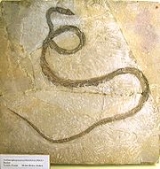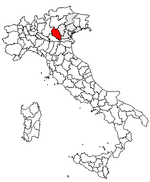
Bolca
Encyclopedia


Veneto
Veneto is one of the 20 regions of Italy. Its population is about 5 million, ranking 5th in Italy.Veneto had been for more than a millennium an independent state, the Republic of Venice, until it was eventually annexed by Italy in 1866 after brief Austrian and French rule...
, on the southern margin of the Italian
Italy
Italy , officially the Italian Republic languages]] under the European Charter for Regional or Minority Languages. In each of these, Italy's official name is as follows:;;;;;;;;), is a unitary parliamentary republic in South-Central Europe. To the north it borders France, Switzerland, Austria and...
Alps
Alps
The Alps is one of the great mountain range systems of Europe, stretching from Austria and Slovenia in the east through Italy, Switzerland, Liechtenstein and Germany to France in the west....
. It is a frazione
Frazione
A frazione , in Italy, is the name given in administrative law to a type of territorial subdivision of a comune; for other administrative divisions, see municipio, circoscrizione, quartiere...
of the comune
Comune
In Italy, the comune is the basic administrative division, and may be properly approximated in casual speech by the English word township or municipality.-Importance and function:...
of Vestenanova
Vestenanova
Vestenanova is a comune in the Province of Verona in the Italian region Veneto, located about 90 km west of Venice and about 25 km northeast of Verona...
, in the province of Verona
Province of Verona
The Province of Verona is a province in the Veneto region of Italy. Its capital is the city of Verona.-Overview:The province has an area of 3,109 km², and a total population of 912,981...
. The area is famous for the marine fossils from the lagerstätte
Lagerstätte
A Lagerstätte is a sedimentary deposit that exhibits extraordinary fossil richness or completeness.Palaeontologists distinguish two kinds....
of Monte Bolca
Monte Bolca
Monte Bolca is a lagerstätte near Verona, Italy that was one of the first fossil sites with high quality preservation known to Europeans, and is still an important source of fossils from the Eocene....
. It was one of the first fossil sites with high quality preservation known to Europeans, and is still an important source of fossils from the Eocene
Eocene
The Eocene Epoch, lasting from about 56 to 34 million years ago , is a major division of the geologic timescale and the second epoch of the Paleogene Period in the Cenozoic Era. The Eocene spans the time from the end of the Palaeocene Epoch to the beginning of the Oligocene Epoch. The start of the...
.
Geography
Bolca lies in the Lessini Alps. Monte Bolca was originally at the bottom of the Tethys OceanTethys Ocean
The Tethys Ocean was an ocean that existed between the continents of Gondwana and Laurasia during the Mesozoic era before the opening of the Indian Ocean.-Modern theory:...
before being uplifted from the ocean floor during the formation of the Alps
Alps
The Alps is one of the great mountain range systems of Europe, stretching from Austria and Slovenia in the east through Italy, Switzerland, Liechtenstein and Germany to France in the west....
. This happened in two stages, one 24 million years ago and one between 30 and 50 million years ago.
History
The area was settled in prehistoric times, there are remains of a hill fort on Monte Purga dating from around 1000 BC. The Romans were active in the area, and by 1000AD the village had come under the control of a convent of the Augustinian Eremitani. In the thirteenth century the fortunes of the Vestenanova area were closely tied to the Ghibelline Ezzelino da RomanoEzzelino da Romano
Ezzelino da Romano was the name of various seignors of fiefs and cities in northern Italy starting from the 12th century AD.*The family was founded by Ecelo , who received the fiefs of Romano, including Romano d'Ezzelino and Onara, near Cittadella, Veneto*Ezzelino II il Balbo*Ezzelino II da Romano,...
family, the Lords of Verona, whose estates were razed in 1260. The Mezzagonella's castle of "Bubulka cum Vulpiana" was seized by Mastino I della Scala
Mastino I della Scala
Mastino I della Scala , born Leonardo or Leonardino, was an Italian condottiero, who founded the Scaliger house of Lords of Verona....
, Ezzelino III da Romano
Ezzelino III da Romano
Ezzelino III da Romano was an Italian feudal lord in the March of Treviso who was a close ally of the emperor Frederick II and ruled Verona, Vicenza and Padua for almost two decades...
's successor, from Ludovico count of San Bonifacio during the 1269-70 war between the Guelphs and Ghibellines
Guelphs and Ghibellines
The Guelphs and Ghibellines were factions supporting the Pope and the Holy Roman Emperor, respectively, in central and northern Italy. During the 12th and 13th centuries, the split between these two parties was a particularly important aspect of the internal policy of the Italian city-states...
. From then on the village was part of Verona, but gained its independence in 1326 by edict of Cangrande I della Scala
Cangrande I della Scala
Cangrande della Scala was an Italian nobleman, the most celebrated of the della Scala family which ruled Verona from 1277 until 1387. Now perhaps best known as the leading patron of the poet Dante Alighieri, Cangrande was in his own day chiefly acclaimed as a successful warrior and autocrat...
. In 1387 the area passed to the Duchy of Milan
Duchy of Milan
The Duchy of Milan , was created on the 1st of may 1395, when Gian Galeazzo Visconti, Lord of Milan, purchased a diploma for 100,000 Florins from King Wenceslaus. It was this diploma that installed, Gian Galeazzo as Duke of Milan and Count of Pavia...
; under Gian Maria Visconti
Gian Maria Visconti
Gian Maria Visconti was the second Visconti Duke of Milan, the son of Gian Galeazzo Visconti and Caterina Visconti.-Biography:...
it fell to Venetian rule from 1410 until the fall of the Venetian Republic in 1797. After the defeat of Napoleon, the Kingdom of Lombardy-Venetia became part of the Austrian Empire
Austrian Empire
The Austrian Empire was a modern era successor empire, which was centered on what is today's Austria and which officially lasted from 1804 to 1867. It was followed by the Empire of Austria-Hungary, whose proclamation was a diplomatic move that elevated Hungary's status within the Austrian Empire...
, during which time Francis I of Austria spent three days in Bolca. In 1821 Bolca was split from Volpiano, the former being joined to Vestenanova, whilst Volpiano became a frazione of Crespadoro
Crespadoro
Crespadoro is a town in the province of Vicenza, Veneto, Italy. It is north of SP43. As of 2007 Crespadoro had an estimated population of 1,699.-Sources:*...
, a town now in the province of Vicenza
Province of Vicenza
The Province of Vicenza is a province in the Veneto region of northern Italy. Its capital city is Vicenza.The province has an area of 2,723 km², and a total population of 840,000 . There are 121 comuni in the province...
.
The fossils at Monte Bolca have been known since at least the 16th century, and were studied intensively in the 19th century once it was definitively proven that fossils were the remnants of dead animals.
Fossils
Strictly speaking, the Monte Bolca site is one specific spot near the village, known as the Pesciara ("The Fishbowl") due to its many marine fossils. However, there are several other related outcroppings in the general vicinity that also carry fossils, such as Monte Postale and Monte Vegroni. The term Monte Bolca is used interchangeably to refer to the original site, or to all the sites collectively.The entire formation consists of 19 metres of limestone, all of which contain fossils, but interspersed in which are the lagerstatten layers that contain the highly preserved specimens. Within these layers, the fish and other specimens are so highly preserved that their organs are often completely preserved in fossil form, and even the skin colour can sometimes be determined. The normal rearrangement of the specimens caused by mud-dwelling organisms in the layer before it turned to stone has been avoided -- it is assumed that the mud in question was low in oxygen, preventing both decay and the action of scavengers.
Fossils from Monte Bolca are commonly available for sale by commercial fossil dealers, and due to their popularity and preservation regularly sell for several hundred euros. Fossil species include the moonfish Mene rhombea
Mene rhombea
Mene rhombea was a perciform fish found in the Tethys Ocean during the Eocene . As suggested by their fossils' small, upturned mouths, and by comparison of its living relative, M. maculata, M. rhombea was a planktivore. Their fossils from the laggerstat Monte Bolca are greatly valued....
and Mene oblonga
Mene oblonga
Mene oblonga is a species of perciform fish that first appeared in the Monte Bolca Lagerstatten during the Lutetian epoch of the Eocene. For a menid, it has a very shallow body, especially in comparison with the sympatric Mene rhombea. Its fossils are very rare in Monte Bolca. A single fossil...
, the batfish
Batfish
Batfish is a name given to several fishes:* The California batfish or sting ray .* Some members of the family Ephippidae.* Some members of the family Ogcocephalidae, including the Pancake batfish.and:...
Eoplatax papilio, the spadefish Exellia velifer, the fish Ceratoichthys
Ceratoichthys
Ceratoichthys pinnatiformis is an extinct species of lookdown-like prehistoric jackfish that lived during the Lutetian epoch, of the Middle Eocene of Monte Bolca, Italy....
, a crocodile
Crocodile
A crocodile is any species belonging to the family Crocodylidae . The term can also be used more loosely to include all extant members of the order Crocodilia: i.e...
, Crocodilus vicetinus, and a snake, Archaeophis bolcaensis.
Economy
The area is dependent on tourism and agriculture; the famous wine regions of ValpolicellaValpolicella
Valpolicella is a viticultural zone of the province of Verona, Italy, east of Lake Garda. The hilly agricultural and marble-quarrying region of small holdings north of the Adige is famous for wine production. Valpolicella ranks just after Chianti in total Italian Denominazione di Origine...
and Soave
Soave
Soave is a small comune of the Veneto region in the Province of Verona, Italy with a population of roughly 6,800 people.-Geography:Soave is located approximately 23 kilometers east of Verona and is reachable by use of the A4 motorway exit Soave-San Bonifacio.-History:Soave was a Roman center on the...
lie just to the south. In the village there is a museum with three rooms of fossils from the area.
External links
- www.bolca.it - Site of the Pro Loco of Bolca
- www.fossilis.fr - Les fossiles de Bolca - Fossils of Bolca - I fossili di Bolca

